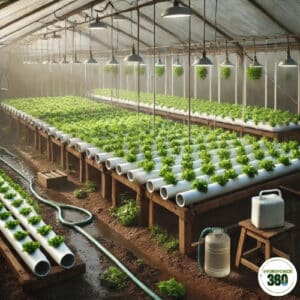Sustainable Hydroponic Farming for Everyone
Table Of Content
For over a decade, hydroponic systems have been growing in popularity across the globe thanks to their fast and effective advantages. If you are one of the hydro growers, you should know the fact that these systems can be quite expensive to maintain. How about mixing these systems with nature and saving money? Then, hydroponic farming is an excellent choice for you!
As you might know, in traditional farming, growers use the natural fertility of the ground, but outdoor hydroponic farming offers a way to grow plants without using any soil. Plants get their nutrients directly from their roots with water systems. This allows farmers to have complete control over nutrient levels, water supply, and growing conditions so that faster growth and higher yields can be achieved.
Unlikely, indoor hydroponic systems and outdoor hydroponic farming don’t use any artificial lights or ventilation; with fresh air and natural sunlight, plants will grow faster than any other method. Continue reading to learn more about hydroponic farming.
Points for Outdoor Hydroponic Farming
Outdoor hydroponic farming comes with a lot of advantages and benefits that are loved by many plants and growers! Such as:
Reduced Soil Dependency and Water Conservation
The biggest and main advantage of outdoor hydroponic farming is that there is no need for soil anymore. If you live in an area with degraded soil conditions, this method can be your solution. Also, in traditional farming, farmers have to use lots of water, and it is lost to the ground most of the time. However, with hydroponic farming, you can save water and money since the water is recirculated within the system.

Potential for Higher Yields and Faster Growth Rates
When you compare outdoor hydroponic farming with traditional ways, the most distinct advantage would be the growth rates. With optimized solutions, hydroponic systems give the nutrients directly to the roots and when you take advantage of natural sunlight, you can see that the growth rate will be much higher.
Space Efficiency and Suitability for Urban Agriculture
In the last 10 years, urban farming has increased; people are looking for ways to get away from urban life with their hobbies, gardens, and more. However, in urban areas, finding sufficient space can be quite difficult. In this crisis, growers can easily adjust their outdoor farming systems to make the most of the space they have with vertical farming techniques, stacked hydroponic setups, and rooftop installations.
Reduced Need for Chemical Fertilizers
Using fertilizer is an important thing for plants to get their nutrients in traditional farming. However, it’s quite expensive and there’s a lot of environmental impact from agricultural runoff, such as water pollution. But, thanks to outdoor hydroponic farming, plants can get their nutrients without any excessive fertilizer use in a controlled way, which means that your plants will be healthier, and synthetic chemicals will be reduced significantly.
Outdoor Hydroponics Comes with Its Challenges
Even though this method offers really good advantages, it also comes with its own challenges that you need to be aware of beforehand, such as:
- Unpredictable Weather Conditions: The problem with hydroponic farming is the weather conditions. Conditions can be quite unpredictable; it could be a sunny afternoon and suddenly it could rain cats and dogs. Factors like fluctuating temperatures, strong winds, and extreme weather can mess up your plants’ growth easily or damage your system. There are, of course, protective measures like barriers, shadings, and insulation to cover your plants, but yet again, sometimes measures cannot prevent the damage; keep it in mind.
- Water Loss and Contamination Risks: Growing plants in hot and dry climates requires a lot of water and this applies to outdoor hydroponic farming too. Evaporation is a big problem. Additionally, if you have an open system for outdoors there’s a contamination risk because of dust, bacteria, and debris. However, you can easily prevent them by using covers, filters, and occasional water quality checks.
- Watch and Adapt: Any grower needs to pay attention to any hydroponic system but if you want to do outdoor hydroponic farming, you have to be more careful. Outdoor systems require much more attention due to sudden changes in water temperature, pH levels, and nutrient concentrations because of environmental effects. These sudden changes can affect the health of your plants and lead to root rot.
As you can see, these are the most common problems that you need to know about before using outdoor systems. With careful caregiving and monitoring, there is nothing that you cannot achieve here!
Systems for Outdoor Hydroponic Farming
There are many systems that are suitable for outdoor farming. Based on your region, climate, what you’re growing, the space you have, and water efficiency, you can choose the right system.
- Nutrient Film Technique (NFT): Minimum water, minimum space! NFT is an excellent choice for small and shallow-rooted plants such as lettuce. With this system, you can create fast-growing environments for your plants because it circulates a thin film of nutrient-rich water over plant roots.
- Deep Water Culture (DWC): An amazing system for larger plants like tomatoes and cucumbers because DWC is suspended in nutrient-rich water with their roots fully submerged, allowing for rapid growth and strong root development.
- Drip System: In a controlled way, the nutrient solution is delivered directly to plant roots through a slow-drip mechanism. This setup works well for a wide range of crops, including fruit plants, and is highly water-efficient, reducing waste in outdoor environments.
- Aeroponics: When aeroponics systems are used, plants are held in the air and the system is misting the roots with nutrient-rich solutions. You can have fast growth and high oxygen absorption for your plant, but you need to pay close attention to their process.
Pest Control in Outdoor Hydroponics
Insects like aphids, whiteflies, and spider mites can quickly infest any plant outdoors, but they can choose hydroponic systems because of the high nutrient levels. Since they are outdoors, they are more exposed to pests that can damage plants and disrupt growth. Additionally, larger pests such as birds and rodents can target outdoor systems causing physical damage.
There are two common options for pest control. One is using natural or chemical methods, and the other is physical barriers.
Organic solutions like neem oil, insecticidal soaps, and beneficial insects can be quite helpful to control the pest populations. However, if you are experiencing severe infestations, hydroponic-safe chemical treatments can be used but there’s always a risk of affecting nutrient solutions. Mesh netting, row covers, and greenhouse-style casings prevent larger pests from infesting the outdoor hydroponic systems too.
FAQs
Does outdoor hydroponic produce taste different from produce grown using traditional farming methods?
No, there are no differences between hydroponics and soil-based growing. Hydroponic produce can taste just as flavorful as soil-grown produce.
Is there any special permit or licensing required to start an outdoor hydroponic farm in urban areas?
It depends on your region because many cities treat hydroponic farms similarly to other urban agriculture initiatives, but some may require permits for water usage, runoff management, or commercial agriculture activities.
How do I maintain stable water temperatures for my outdoor hydroponic system, especially in regions with extreme weather fluctuations?
Maintaining an ideal water temperature (generally around 65–75°F or 18–24°C) is crucial for healthy plant growth. Insulate the reservoir with foam or reflective wraps and place it in shaded or partially buried spots. Use small chillers or heaters if needed and monitor water temperature regularly.
Table Of Content
